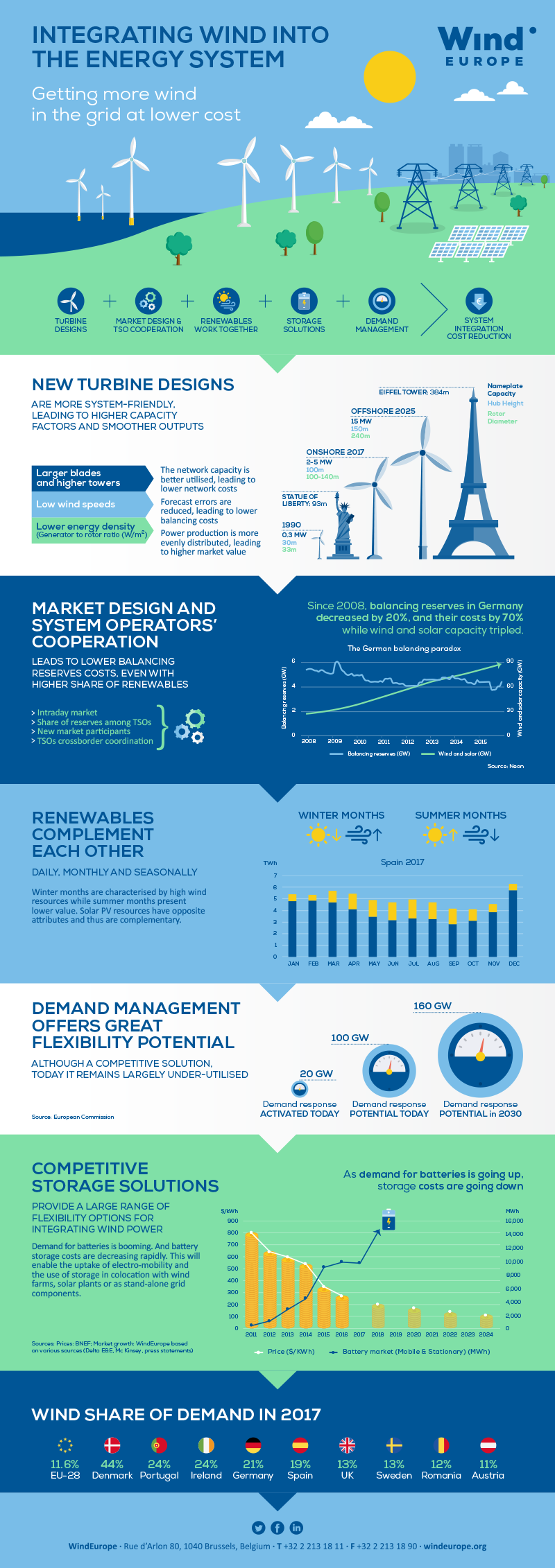20 February 2018
Smarter roll-out of electricity grids makes integrating 35% renewables easier and cheaper
The integration of increasing shares of renewable energy into electricity grids is getting easier and cheaper. Smart grids, demand response, flexible wind turbines and storage are helping to do this. But we need to upgrade and expand the grid to secure the significant cost savings that an interconnected power market could offer.
If renewables are to meet 35% of Europe’s energy needs by 2030, then investments in electricity grids need to be more strategic. That’s what the Renewables Grid Initiative and WindEurope will tell participants at today’s Grids meet Renewables conference in Brussels.
To deliver an adequate grid in Europe and further reduce system costs, the extension of electricity infrastructure needs to be done in a smarter way. Three things are needed in order to do this.
First, renewable energy producers – including wind – and grid operators need to work together more closely. Defining the future energy landscape requires joint planning on the development of new transmission lines. This should take into consideration the expansion of renewables and the electrification of other sectors, as well as environmental and social impacts. Countries can help facilitate this by detailing the volumes of renewable energy they will deploy post-2020 as part of their National Energy & Climate Plans. This will give much-needed clarity to grid operators on where to invest in additional infrastructure. And will therefore help to avoid grid bottlenecks that we’ve seen on domestic and European level.
Second, to accommodate for increasing electrification in other sectors the EU needs to prioritise electricity grids over gas grids when it’s allocating funds under the Connecting Europe Facility. The electrification of heating, transport and industrial processes is essential for the transition to a low-carbon economy. This needs to come with an extension and upgrade of electricity grids across Europe. Good examples are projects like Biscay Gulf (Spain) and SuedOstLink (Germany) for which EU support was recently announced.
Third, the software of power markets also needs to be fixed. ‘Grid support services’ – whereby renewable generators can ramp up and down supply according to demand – should be increasingly commoditised. New wind power plants are technically able to provide these services and many countries already impose these responsibilities on wind farms. But many markets still do not allow wind power plants to provide and be compensated for these services.
WindEurope CEO Giles Dickson said: “The energy sector is transforming rapidly. This transformation needs a common vision, shared by both the renewables and grid industries. The investments in new electricity grids are essential to ensure Europe can fully exploit its wind resource. A smarter approach to how we develop the grids will allow wind energy to provide an ever greater part of consumers’ energy needs. This will be key in meeting an ambitious renewables target for 2030.”
Renewables Grid Initiative CEO Antonella Battaglini said: “In the next decade, massive growth of renewables as well as related grid development need to be supported. This can only be realised if we at the same time protect nature and involve society in the process. This requires multidisciplinary skills and collaborative processes to properly address peoples’ concerns and desires for a more sustainable and at the same time affordable energy future. Each day we learn how to better integrate renewables and how to deliver better projects on the ground. To continue on this joint path, this learning exercise also needs to continue and be enhanced.”


